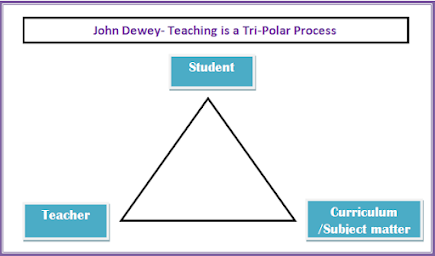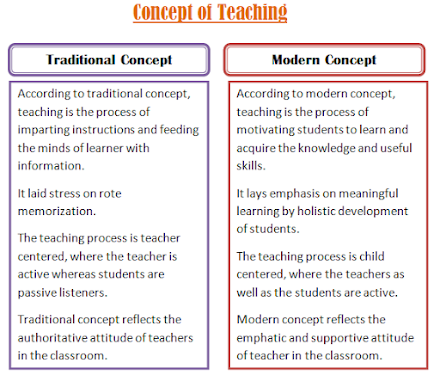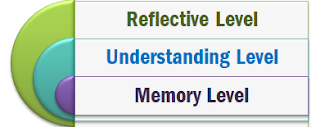Content
Introduction
Definition of Teaching
Concept of Teaching
Nature of Teaching
Introduction:
Teaching is
an important part of the process of education. Its main function is to impart
knowledge, develop understanding and skill.
According to
John Dewey, teaching is a Tri-polar process. There are three poles in the
process of teaching – the teacher, the student and the subject matter (or
curriculum).
Teaching is the process by which teacher brings students and
subject matter (or curriculum) together to facilitate meaningful learning of
student. Both teachers and students are active in this process, where the
former is teaching and the latter is learning.
For the teaching process to be effective, the teacher should
not only have good content knowledge of the subject but also good planning,
classroom management and organization, communication skills, confidence,
empathy etc.
Definitions of Teaching
According to H.C. Morrison,
“Teaching
is an intimate contact between the more mature personality and a less mature
one, which is designed to further the education of latter.”
According to Burton,
“Teaching
is the stimulation, guidance, direction, and encouragement of learning.”
According to Clarke,
“Teaching
refers to activities that are designed and performed to produce change in
student (pupil) behavior.”
According to Albert
Einstein,
“The
supreme art of teaching is to awaken joy in creative expression and
understanding.”
According to W.R.
Ryburn,
“Teaching
includes the training of emotions of the child. It is one of the means of
giving right feeling to the children.”
According to Jackson,
“Teaching
is a face to face encounter between two or more persons, one of whom (teacher)
intends to effect certain changes in the other participants.”
According to N.L. Gage,
“Teaching
is a form of interpersonal influence.”
Concept of Teaching
The concept of teaching is seen in two forms : Traditional and Modern Concept.
- Teaching is a tri-polar process- the three interconnected poles are the teacher, the student and the subject matter (or curriculum.)
- Teaching is an interactive process, where the teachers and students actively participate and interact to bring about desirable behavioral changes in students.
- Teaching is a planned process in which the content and teaching material is selected and planned by the teacher in a systematic and organized manner to facilitate meaningful learning of students.
- Teaching is the motivation to learn. As per Burton, “Teaching is the stimulation, guidance, direction, and encouragement of learning.”
- Teaching is a formal as well as informal process. Teaching is formal process when it is done consciously in a well planned and structured way i.e. in schools, whereas teaching is informal process when it is done a unconsciously or consciously i.e. at home or outside school.
- Teaching is a flexible process in which changes or modifications are made in the preplanned lesson during the teaching process to cater to the individual needs of the students.
- Teaching takes place at multiple levels, which are:
- Teaching is a conscious as well as unconscious process.
- Teaching is task oriented.




Comments
Post a Comment